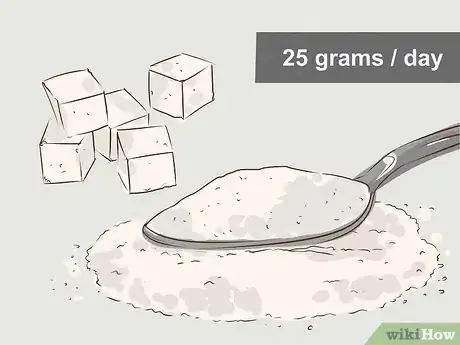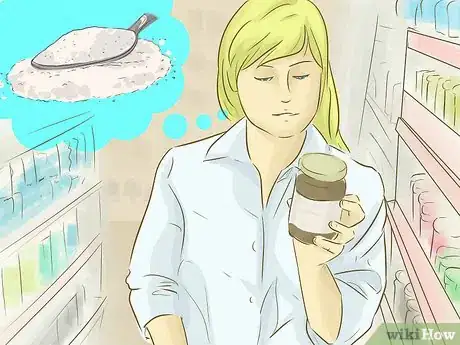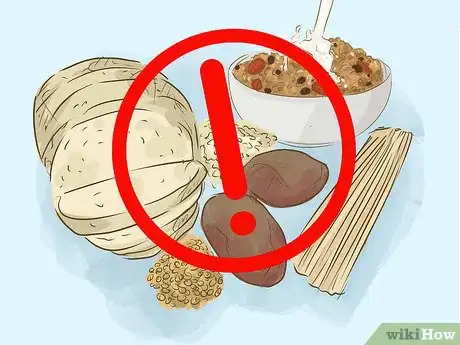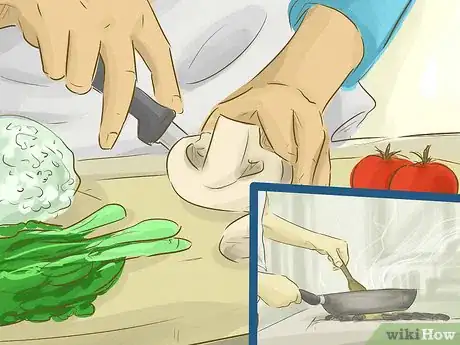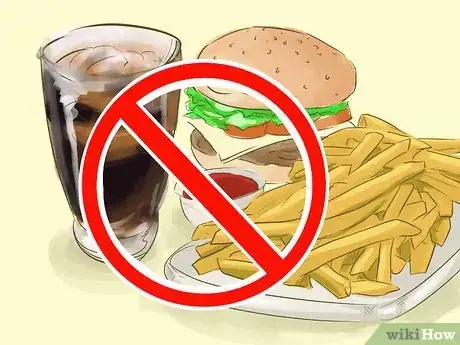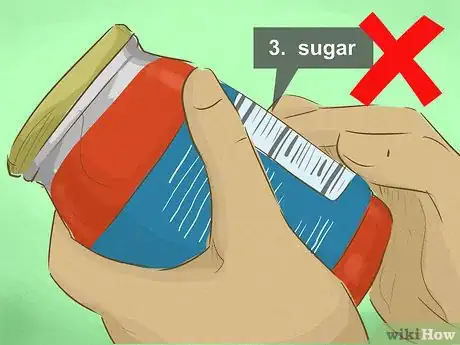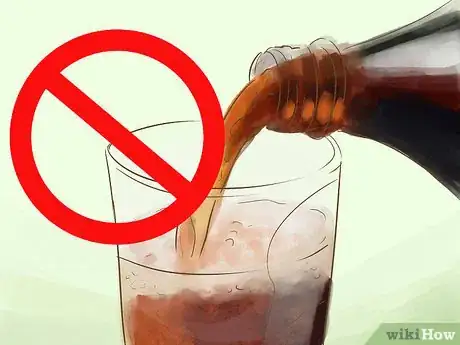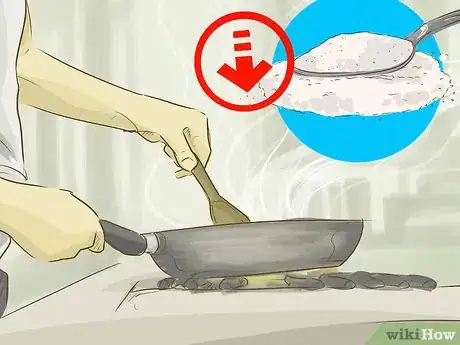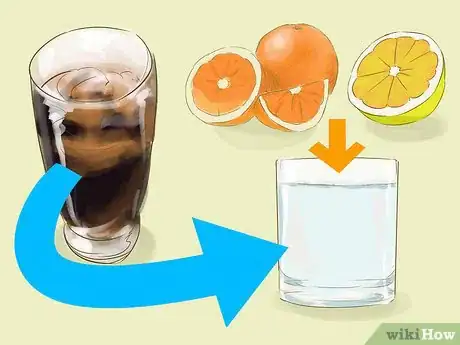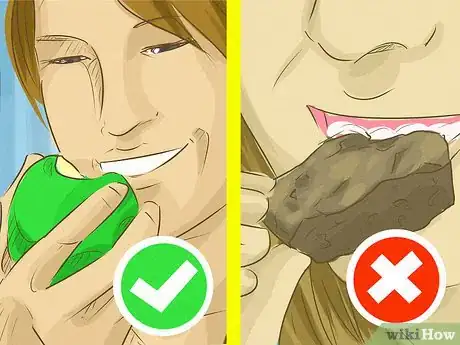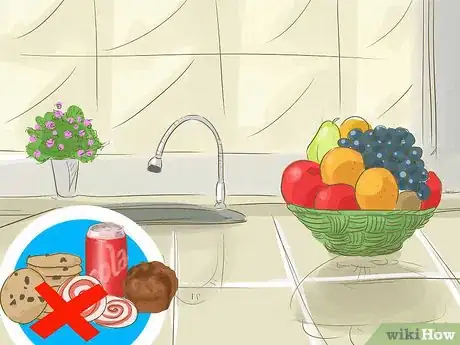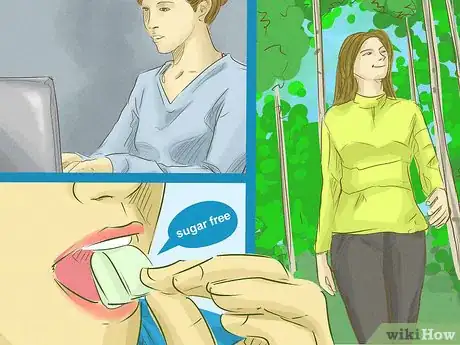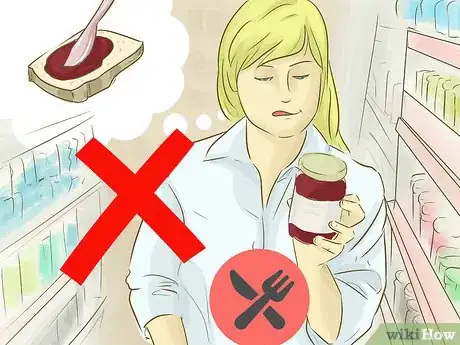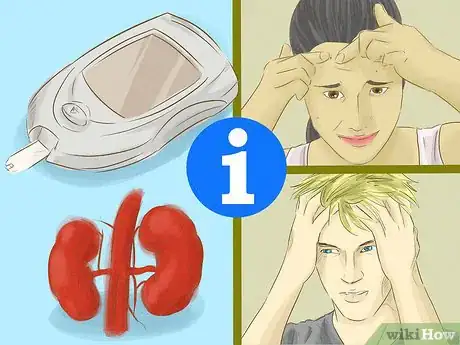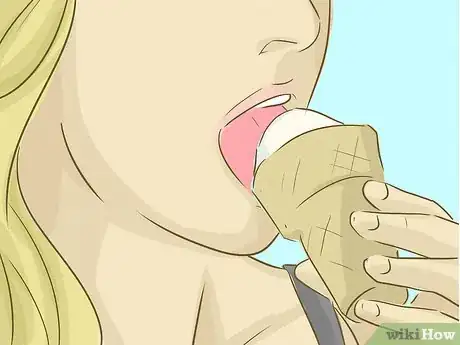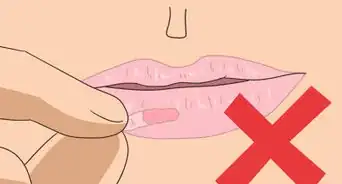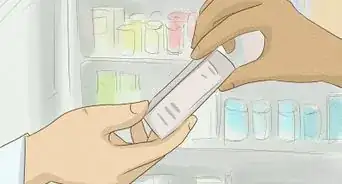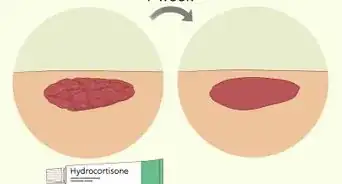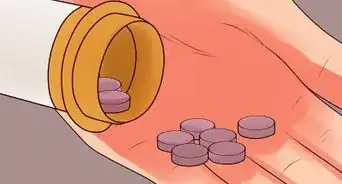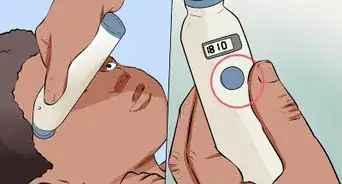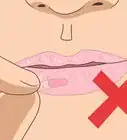This article was co-authored by Lyssandra Guerra. Lyssandra Guerra is a Certified Nutrition & Wellness Consultant and the Founder of Native Palms Nutrition based in Oakland, California. She has over five years of nutrition coaching experience and specializes in providing support to overcome digestive issues, food sensitivities, sugar cravings, and other related dilemmas. She received her holistic nutrition certification from the Bauman College: Holistic Nutrition and Culinary Arts in 2014.
There are 24 references cited in this article, which can be found at the bottom of the page.
wikiHow marks an article as reader-approved once it receives enough positive feedback. In this case, 100% of readers who voted found the article helpful, earning it our reader-approved status.
This article has been viewed 557,068 times.
Though we don't need refined sugars in our diet, humans seem hardwired to crave sweet foods. In fact, research suggests that sugar can act on the brain in the same way as addictive substances like tobacco![1] Unfortunately, the sugar we love is also the culprit in a wide range of diseases, from cavities and diabetes to fatigue and obesity. [2] Reducing sugar's role in your life can only benefit you and your loved ones.
Steps
Preparing to Change Your Diet
-
1Set a sugar limit. You may only think about sugar when you add it to your recipes or coffee, but you likely eat large amounts of it without even thinking about it. Make a commitment to consciously count how many grams of sugar you eat on a daily basis, and limit your sugar to a healthy amount. The World Health Organization recommends eating no more than 25 grams (0.88 oz) of sugar per day — less than what’s found in a single soft drink.[3]
- Pace your sugar intake throughout the day by eating foods with a moderate amount of sugar, rather than one sugary food and a lot of sugarless food.
- Less than 5g of sugar per 100g serving of food is a good, low-sugar product.[4]
- More than 15g of sugar per 100g serving of food is too high for healthy consumption.
- If you are going to consume sugar, try to use healthy sugar alternatives like agave syrup, honey, coconut sugar, etc. Natural sugars (while still sugars) are much better for you.
-
2Track your sugar. If you don't want to give up on all sugar, make a weekly chart to keep track of how much sugar you're eating. Decide how much sugar you are going to allow yourself to eat each day, remembering that you should eat no more that 25 grams (0.88 oz), maximum.
- For instance, on Mondays you might need an extra kick in your morning coffee, so you can allow yourself two sugars in it. If you have plans to go out with friends on Saturday, allow yourself dessert.
- You can decide how restricting or not your graph is.
-
3Identify the sugar sources in your diet. Cut out or scale back on seemingly “healthy” foods that are actually adding large amounts of sugar to your diet. Look closely at the nutrition labels on all the food in your pantry to see how many grams of sugar they contain; four grams of sugar is equal to a teaspoon of granulated sugar. Even the healthier foods you eat might have surprisingly high sugar contents![5]
- For example, a small cup of packaged applesauce can have 22g of sugar in it! That’s the same as eating five and a half teaspoons of sugar!
- Other foods likely to be high in sugar include cereals, canned products, juice and canned fruits, flavored dairy products (like yogurt), microwaveable or other ready-made meals, and sodas.
- If possible, eat non-packaged or canned products. For example, instead of a sugar heavy cereal for breakfast, make old fashioned oatmeal and add fruit to make it sweeter.
-
4Recognize and avoid sugar aliases. [6] Nutrition labels include a list of ingredients that often call sugar by different names. Know the different aliases for sugar so you can avoid sugar-heavy foods. Ingredients that end in “ose,” like glucose, sucrose, fructose, lactose, dextrose, or maltose, are all forms of sugar. Other common aliases include:
- High fructose corn syrup
- Corn syrup
- Molasses (Blackstrap molasses is better.—It has had much of the sugar removed as crystals.)
- Invert, brown, or raw sugar
- Corn sweetener
- Syrup
Altering Your Diet
-
1Limit your carbohydrate intake. Some people choose to cut sugary, carbohydrate-rich foods like white rice, bread, pasta, and potatoes out of their diet completely. If that seems too drastic, you can keep them in your diet, but make sure to eat them in moderation. These foods draw you into a cycle of sugar cravings by causing a sudden sugar spike in your system. Your body releases a large amount of insulin to manage the spike, which then causes your blood sugar levels to drop. This, in turn, makes your body crave more sugar, restarting the cycle.[7]
- The “white” varieties of bread, rice, and pasta are the most dangerous. In place of simple carbohydrates, incorporate complex carbohydrates like sweet potatoes, quinoa, and oats, whole grain bread, brown rice, and whole grain pasta.[8]
-
2Cook your own meals. When you eat out, you have only a limited idea what's going into your meals. When you cook for yourself, you have complete control over what goes into your body. Cook natural products like vegetables, fruits, meats, and grains from scratch rather than preparing boxed meals.[9]
- When you eat out, don't feel uncomfortable making special requests. You can ask for your meat grilled instead of fried and your vegetables steamed instead of sautéed in oils.
- You can use an online nutrient calculator to make sure the ingredients you use in a given meal provide a balanced diet.[10]
A balanced diet is really important.[11]
It is generally accepted that you should get the following macronutrient percentages:
- 40% of your calories from protein
- 40% from carbohydrates
- 20% from fat
- If you actually track your macronutrient intake, you will likely notice that you aren't consuming nearly enough protein, and you are way high on carbohydrates and fat. Apps like My Fitness Pal help you to become aware of what you are putting into your body.
-
3Replace refined sugars with natural ones. The sugars in most processed foods are bad for your health, but those found naturally in fruits and in vegetables come packaged with other health benefits. Replace your candy bar with nutrient-packed fruits like bananas and dates. Even when baking, you can replace sugar with fruits! Puree bananas, cooked apples, or cooked butternut squash to sweeten your cakes, ice creams, or smoothies.[12] Many fruits can be baked to make them dessert-like. For example, you can bake an apple and then add cinnamon. And in many packaged cake, cookie, and brownie mixes, you can often substitute apple sauce for some of the ingredients to make it lighter.—Just make sure to check the nutrition label to ensure that the apple sauce has no added sugar.[13]
-
4Cut fast food out of your diet. Even savory fast foods that don’t taste particularly sweet are often full of refined sugars. For example, a “grilled” or “charbroiled” chicken breast at a fast food restaurant likely achieves that taste with sugar.[14] Fast food chains try to achieve taste as quickly and cheaply as possible and almost always use sugar as a shortcut for good cooking. Instead, eat at a restaurant that spends a little more time on its food, or just cook your own meals at home.[15]
- Three out of every four teaspoons of sugar Americans eat is consumed through processed food.[16]
- Eating out is often inevitable. It will happen from time to time. And, when it does, take the time to look up the menu of the restaurant ahead of time and decide what the healthiest option is. Your body will thank you.
-
5Avoid products that list sugar among the first three ingredients. The ingredient list on a nutrition label lists ingredients in descending order based on how much of of each one is found in the product. If you find sugar (or any of its aliases) listed in the first three ingredients, the sugar content is too high. And, if the nutrition information lists more than one type of sugar in the product, you should avoid that food at all costs.[17]
- Be wary of products claiming to be a "natural" or "organic" substitute for sugar. These sweeteners still have calories, but don't add any nutrients to your diet.
- "Reduced-sugar" products still have sugar in them, and are best avoided. Whatever product was used to replace the original sugar content will most likely be bad for your health as well.
-
6Stop drinking sugary drinks. The average soft drink has nine teaspoons of sugar in it, compared to the World Health Organization recommendation of six teaspoons per day. Diet sodas might not have calories, but they’re still full of artificial sugars that increase the risk for diabetes and obesity.[18]
- While energy drinks might give you the boost you need to get through the workday, they’re packed with unhealthy sugars.
- Sugary drinks are such a common pitfall in a modern diet. Some iced teas and sodas have almost half of your recommended daily limit of carbohydrates and sugar. Be conscious of how much sugar you’re drinking!
- Even healthy, natural juices that have no added sweeteners are packed with naturally occurring fructose. The natural sugars are more healthful, but water is better.
-
7Don't skip breakfast, and make sure it's a healthy and moderate feast. Eat a good breakfast of toast or whole grain cereals or oatmeal/porridge to keep you going through the day.[19] These release energy slowly, so you will be less likely to crave sugar. You should also get some fat and protein in your breakfast through animal protein from eggs, bacon, sausage, or similar foods.[20]
- Avoid sugary cereals an look, instead, for wholesome cereals that brag about having no sugar. Explore the different varieties of porridge you can make, from amaranth to barley. A few blueberries sprinkled on top makes it super delicious!
-
8Reduce the amount of sugar in your cooking and baking. Unlike yeast, flour, and fat, reducing sugar won't affect your final product apart from the taste. Instead of relying on sugar, use various spices to flavor your food—cinnamon and nutmeg, for example.
- For cakes, add one fresh piece of fruit rather than sugar. Bananas are often a great addition, even when they're overripe and good for little else!
- For dessert, use fruit's natural sweetness without added sugar. Poached fruit is always delicious, sprinkled with a spice or served with vanilla custard that is sugar-free.
- Add fresh, unflavored plain yogurt as a topping to a fruit salad. Other delicious choices include a baked apple or frozen berries.
- Toasted sprout bread or some bagels with slices of fruit or a thin layer of sugar-reduced jam can be a hearty substitute for candy cravings.
-
9Replace soda with plain or flavored water. Soda is a leading cause of sugar-related obesity, so it’s very important that you curb your soda habit if you have one.[21] Switching from regular to diet soda affects calorie intake, but might serve to feed your sugar cravings.
- If regular water isn’t enough to keep you happy, try flavoring it with natural flavors.[22] Squeeze some lemon or orange into you water for a citrus drink. Soak cucumber slices or strawberry slices in a pitcher of water for a refreshing, summery glass. You can also buy a water bottle with an infuser to flavor your water. You just add the fruit to the infuser so it keeps the water and fruit separate.
- Unsweetened teas might give you some of the stronger flavors you crave.
- Some people miss the feeling of drinking out of a can, in which case a flavored, sparkling water drink might be a good option for you to help kick a soda habit. These drinks have a wide variety of flavors, from lime to pomegranate, but make sure you choose one that has no added sugar.
-
10Eat healthier snacks throughout the day. Sugary snacks have a habit of sneaking into your daily diet in all sorts of seemingly harmless ways: the morning muffin, the afternoon candy bar, or the evening candies.[23] These soon add up, and mindless munching is not good for your health. To keep yourself satisfied throughout the day, eat healthier snacks like carrot and celery sticks, hummus, a few nuts, or an apple.[24] Be careful of dried fruit; it's full of calories and fructose.
Sticking to Your Commitment
-
1Clear your home of sugary foods. Don’t put temptation in your path! Keeping sugary treats like cookies, sodas, or white breads around your kitchen will only give you an opportunity to slip sugar into your diet. A cookie here and a stolen sip of soda there will add up over the course of the day. When you make the decision to reduce sugar in your diet, throw out or donate all foods whose nutrition labels mark them as too sugary for your new lifestyle.
- This may not be realistic if you live with roommates or family members who don’t share your aversion to sugar. Talk to the people you live with about whether or not they would be willing to alter their diets for their own health.
- If they don’t want to cut down on sugar, separate your food from the rest of the food in the house. Stake out one shelf in the pantry for your own food, and tell yourself you can only eat from that shelf.
- Put your food somewhere else completely, where you won’t even have to see your roommates’ or kids’ sugary foods when you want to grab a snack or prepare a meal.
-
2Manage your sugar cravings. Humans are just hard-wired to love sugar. Carbohydrates, including sugar, release serotonin in the brain, which makes us feel calm, relaxed, and just overall good when we sugary foods. When you cut sugar out of your diet, you may find yourself in sugar withdrawal, but there are things you can do to fight off your cravings.[25]
- Wait out your withdrawals. Just like any other addictive substance, you may feel cravings for the first 2 to 3 days after going cold-turkey with sugar. However, if you can stay strong for those first 72 hours, you’ll find your cravings will diminish.
- Eat something else. You may get sugar cravings when your blood sugar drops too low, likely because you haven’t eaten in some time. Many foods, including vegetables, have sugar in them, though, and you can correct your imbalance without splurging on sugar.
- Distract yourself by doing something else you enjoy. Listen to your favorite album, take a nice walk, or bury yourself in an interesting task at work.
- While fruit is a much healthier option, it does still contain sugar. Eating a snack high in protein combined with a healthy fat will help curb cravings and keep you energized. For example, hard-boiled eggs and almonds.
- Research suggests that chewing gum can effectively fight off sugar cravings. Obviously, look for sugar-free gum!
-
3Don’t shop hungry. This is more than just common-sense folk wisdom — it’s the conclusion of scientific research. People who shop while hungry tend to purchase tasty, but unhealthy products at the grocery store. If you have a sweet-tooth, you’ll be more likely to indulge in your favorite snacks that you would if your hunger was satisfied.
- If you’re hungry when you need to shop, eat a snack to tide you over until you can eat a full meal. A small, healthy snack eaten 5 minutes before your shopping trip will prevent you from bringing sugary foods home.
- Many grocery stores now have options where you can order your groceries ahead of time and pick them up at little cost. This is a great way to control the food that you get in terms of their nutritional value, but it also prevents you from buying things that you just don't need, and in effect saves you money.
-
4Focus on how good you will feel soon. When you cut sugar out of your diet, you’ll likely have strong cravings for at least a couple of weeks. However, if you can push through that initial barrier, you’ll find that your body feels healthier and your mood is improved. A reliance on sugar has been correlated with fatigue, depression, anxiety, poor sleeping habits, and hormonal and digestive problems.[26] Even if you really want one of the free donuts in the break room, think about how much better you will feel once your cravings have passed. Be assured that just like any other "addiction," your severe sugar cravings will get better once your body has adjusted to the absence of sugar.
-
5Remind yourself of sugar-related risks.[27] Sugar is related to a wide variety of health issues, many of which might prove fatal if you don’t address your sugar consumption. Whenever you get a sugar-craving, remind yourself why you’re doing this: sugar is a cause of acne, infertility, certain cancers, osteoporosis, vision loss, and kidney disease. It’s also related to mood swings, depression, fatigue, and memory loss.[28] Research suggests that sugar can cause fatal heart disease even in thin patients who seem outwardly healthy.[29] Moreover, sugar is known as an “empty calorie,” meaning it adds calories to your body without any nutritional value. As such, sugar is closely linked with obesity — more so than even fat content.[30]
- While the causes of diabetes are complex, Type-2 diabetes is known to be caused by a combination of genetic predisposition and lifestyle choices, including diet.[31] Though eating sugar will not necessarily lead to diabetes, it puts you at a higher risk, especially if you have diabetes in your family.
- Though not the only cause, sugar is certainly the leading cause of tooth cavities that can be both painful and expensive to treat.[32] Sugary foods can lead to tooth decay or gum disease.[33]
-
6Treat yourself from time to time. If you cut sugar out of your life entirely, you might find yourself thinking about it all the time. Instead, keep your sugar intake within the World Health Organization’s recommendation, which is 25 grams (0.88 oz) per day, and give yourself a treat once a week. Pick a day when you think you’ll need a treat, and let yourself cheat when you need to. Maybe you need a big, sugary donut breakfast every Monday to prepare for the work week, or maybe you need to unwind with a giant bowl of ice cream when you get home from work on Fridays.
- Many dieticians believe that allowing yourself to cheat on any kind of restricted diet improves your chances of sticking to the diet long-term.[34]
Expert Q&A
-
QuestionWhat happens when you eliminate sugar from your diet?
 Lyssandra GuerraLyssandra Guerra is a Certified Nutrition & Wellness Consultant and the Founder of Native Palms Nutrition based in Oakland, California. She has over five years of nutrition coaching experience and specializes in providing support to overcome digestive issues, food sensitivities, sugar cravings, and other related dilemmas. She received her holistic nutrition certification from the Bauman College: Holistic Nutrition and Culinary Arts in 2014.
Lyssandra GuerraLyssandra Guerra is a Certified Nutrition & Wellness Consultant and the Founder of Native Palms Nutrition based in Oakland, California. She has over five years of nutrition coaching experience and specializes in providing support to overcome digestive issues, food sensitivities, sugar cravings, and other related dilemmas. She received her holistic nutrition certification from the Bauman College: Holistic Nutrition and Culinary Arts in 2014.
Certified Nutrition & Wellness Consultant Your blood sugar levels are going to drop dramatically and you'll end up craving it even harder than you were before. To prevent this, eat balanced meals. Make sure each meal contains a healthy fat, like avocado, and a protein. This will keep your sugar levels from dropping so hard. Then, eat every 2-3 hours and snack in between meals to keep yourself from getting hungry. This will stabilize your blood sugar levels over the course of the day.
Your blood sugar levels are going to drop dramatically and you'll end up craving it even harder than you were before. To prevent this, eat balanced meals. Make sure each meal contains a healthy fat, like avocado, and a protein. This will keep your sugar levels from dropping so hard. Then, eat every 2-3 hours and snack in between meals to keep yourself from getting hungry. This will stabilize your blood sugar levels over the course of the day.
Warnings
- Don't become a sugar-hating fiend. The aim is to reduce your intake by a great deal but there are going to be some foods and occasions where you will consume more sugar than you'd normally do. Everything in moderation is your byword, and also keep the amount of sugar in perspective. For example, a bottle of sauce may contain a lot of sugar, but if you're only adding a dollop, you're consuming very little of it.⧼thumbs_response⧽
- As well as being very careful not to have too much sugar you should not have too little sugar as it can cause blackouts to happen.⧼thumbs_response⧽
- You should check your BMI or Body Mass Index. If you are going to start dieting or anything then make sure you do not become underweight.⧼thumbs_response⧽
Things You'll Need
- Sweet spices
- Clear out of processed foods containing too much sugar
- Healthy recipe collection to inspire you
References
- ↑ Elizabeth Somer, Eat your way to happiness, p. 65, (2009), ISBN 978-0-373-89207-5
- ↑ Elizabeth Somer, Eat your way to happiness, p. 67, (2009), ISBN 978-0-373-89207-5
- ↑ https://www.who.int/news-room/detail/04-03-2015-who-calls-on-countries-to-reduce-sugars-intake-among-adults-and-children
- ↑ http://www.bbcgoodfood.com/howto/guide/truth-about-sugar
- ↑ Lyssandra Guerra. Certified Nutrition & Wellness Consultant. Expert Interview. 25 March 2020.
- ↑ http://www.bbcgoodfood.com/howto/guide/truth-about-sugar
- ↑ https://www.mayoclinic.org/healthy-lifestyle/nutrition-and-healthy-eating/in-depth/carbohydrates/art-20045705
- ↑ http://www.bbcgoodfood.com/howto/guide/truth-about-sugar
- ↑ Lyssandra Guerra. Certified Nutrition & Wellness Consultant. Expert Interview. 25 March 2020.
- ↑ http://nutritiondata.self.com/
- ↑ Lyssandra Guerra. Certified Nutrition & Wellness Consultant. Expert Interview. 25 March 2020.
- ↑ http://healthyeating.sfgate.com/alternatives-refined-sugars-7540.html
- ↑ Lyssandra Guerra. Certified Nutrition & Wellness Consultant. Expert Interview. 25 March 2020.
- ↑ http://www.forbes.com/sites/daviddisalvo/2014/09/24/even-your-grilled-chicken-has-added-sugar/
- ↑ Lyssandra Guerra. Certified Nutrition & Wellness Consultant. Expert Interview. 25 March 2020.
- ↑ Elizabeth Somer, Eat your way to happiness, p. 68, (2009), ISBN 978-0-373-89207-5
- ↑ Lyssandra Guerra. Certified Nutrition & Wellness Consultant. Expert Interview. 25 March 2020.
- ↑ http://www.forbes.com/sites/fayeflam/2014/09/17/an-unintended-consequence-of-diet-soda-disrupting-friendly-bacteria/
- ↑ Lyssandra Guerra. Certified Nutrition & Wellness Consultant. Expert Interview. 25 March 2020.
- ↑ https://www.health.harvard.edu/blog/a-doctors-recipe-for-a-healthy-breakfast-2017100612479
- ↑ http://www.hsph.harvard.edu/nutritionsource/sugary-drinks-fact-sheet/
- ↑ http://www.foodnetwork.com/healthy/packages/healthy-every-week/healthy-tips/12-ways-to-make-water-the-most-delicious-thing-ever.html
- ↑ Lyssandra Guerra. Certified Nutrition & Wellness Consultant. Expert Interview. 25 March 2020.
- ↑ https://www.mayoclinic.org/healthy-lifestyle/weight-loss/in-depth/healthy-diet/art-20046267
- ↑ Lyssandra Guerra. Certified Nutrition & Wellness Consultant. Expert Interview. 25 March 2020.
- ↑ http://abcnews.go.com/Health/Diabetes/addicted-sugar/story?id=10869006
- ↑ Elizabeth Somer, Eat your way to happiness, pp. 72-73, (2009), ISBN 978-0-373-89207-5
- ↑ Elizabeth Somer, Eat your way to happiness, pp. 72-73, (2009), ISBN 978-0-373-89207-5
- ↑ http://www.health.harvard.edu/blog/eating-too-much-added-sugar-increases-the-risk-of-dying-with-heart-disease-201402067021
- ↑ https://www.canr.msu.edu/news/what_are_empty_calories
- ↑ http://www.diabetes.org/diabetes-basics/myths/
- ↑ http://www.webmd.com/oral-health/healthy-teeth-14/cavities-myths
- ↑ http://www.mouthhealthy.org/en/az-topics/d/diet-and-dental-health
- ↑ https://www.webmd.com/diet/features/when-it-comes-to-sweets-never-say-never#2
- Elizabeth Somer, Eat your way to happiness, (2009), ISBN 978-0-373-89207-5 – research source
About this article
If you’re looking for ways to eat less sugar, start by eating less foods like pasta, bread, and potatoes, which make you crave sugar by causing your blood sugar levels to drop. Then, make sure to have healthy snacks such as fruit, nuts, and hummus on hand so that you’re less tempted to reach for sugary snacks. Additionally, check the nutritional labels and avoid products that list sugar among the first 3 ingredients. You can also reduce the amount of sugar in your cooking by flavoring your foods with spices like cinnamon and nutmeg. For more advice from out Nutrition reviewer, including how to stick to your commitment to eat less sugar, keep reading.
